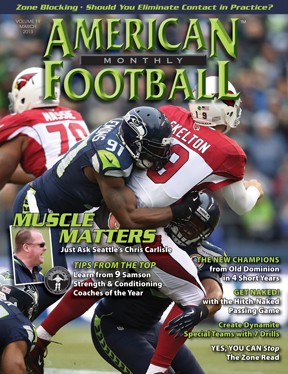Article CategoriesAFM Magazine
|
Get Naked! – Effectively using the Hitch-Naked passing game forces a defense to defend the entire field.by: Matt KalbOffensive Coordinator and Quarterbacks Coach, Aurora University © More from this issue The Hitch-Naked passing game provides our offense with a safe and efficient way to move the ball with high percentage throws while at the same time allowing us to effectively target our playmakers. Any time we can get the ball to our receivers in a position where they can attack a defender in a 10-yard box, we have successfully created an opportunity for a big play. This is exactly what the Hitch-Naked series has provided our offense. When we installed the series in 2009, we had no idea what it would give us. We were looking to trim the offense but still be versatile. Because we are a big horizontal stretch team, we realized that we weren’t running a lot of our 3-step routes. By adding the Hitch-Naked concepts, we could not only eliminate our quick game, but could also cut out the majority of our sprint out plays as well due ....The full article can only be seen by subscribers.
|
|
|||||||
| HOME |
MAGAZINE |
SUBSCRIBE | ONLINE COLUMNISTS | COACHING VIDEOS |
Copyright 2025, AmericanFootballMonthly.com
All Rights Reserved





